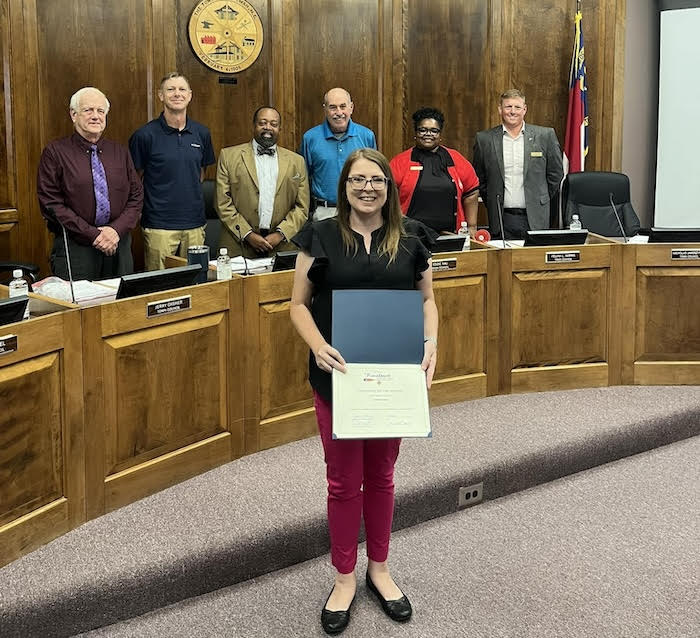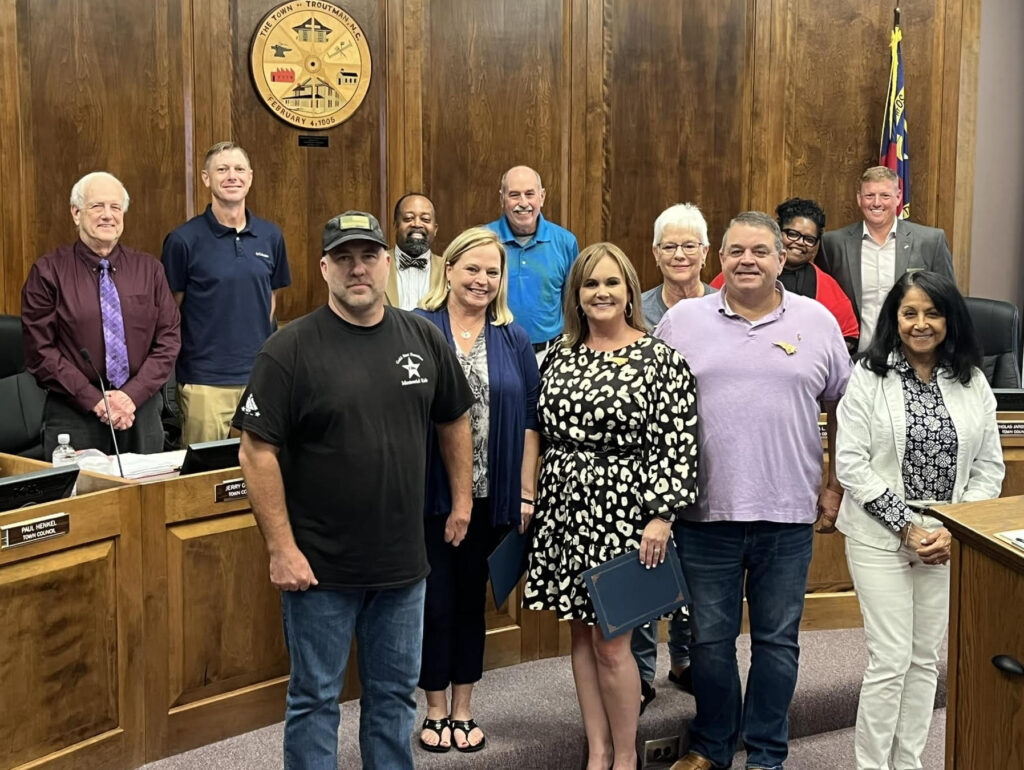
BY DEBBIE PAGE
The Troutman Town Council on Thursday approved a text amendment to replace the Traffic Impact Analysis section of the Troutman Unified Development Ordinance to reflect the town is now controlling TIA processes for new residential and commercial development.
The Troutman Planning and Zoning Board recommended this updated traffic impact analysis (TIA) process in July to give the town more consistency and control in conducting traffic studies. Community members have voiced their desire for traffic solutions in the Highway 21/Main Street corridor for years.
Troutman hired Kimley-Horn, an engineering, planning, and design firm, to conduct all traffic impact studies for proposed development — at the developer’s cost — to create a more consistent process and to have a better picture of the overall traffic impact on the community.
The firm will also help the town on other transportation projects on an as-needed basis.
Kimley-Horn Senior Vice President Steve Blakley gave a short presentation on the changes and explained the proposed new process.
Some of the major proposed changes include:
♦ The actual number of trips calculated for a proposed development will now be the determining factor for the need for a TIA as opposed to the use or square footage of the development.
♦ A process is outlined, including discretion from staff and the consultant, to require a TIA even if the threshold is not met based on other factors. Staff can require a transportation technical memorandum (TTM) on small projects that do not meet the TIA threshold.
♦ The developer or applicant will be required to sign off on a document for all improvements agreed upon and consent to pay the fee for the TIA or TTM. The timing of when the improvements must be installed will also be included.
♦ A fee-in-lieu-of option will be available for situations where a state project is planned but not yet started. This option must be approved on a case-by-case basis by the Town Council.
In the new TIA process, after a development plan is presented to the Planning and Zoning Department, the town will notify Kimley-Horn to perform the TIA. The applicant will pay for the traffic study, completed in conjunction with the town, NCDOT, and the applicant, with the final report being presented by Kimley-Horn representatives to the Town Council at the time of the development’s consideration by the council.
This process creates a more consistent traffic knowledge base that would carry through all projects proposed to the town.
The new TIA threshold is set at 1,000 daily trips or 100 peak-hour trips from 7 to 9 a.m. and 4 to 6 p.m.
The changes would also create more flexibility in TIA requirements. The town may determine that a TIA, TTM, or traffic mitigation agreement (TMA) is needed based on special circumstances or safety concerns associated with the development, even if the number of trips falls below the proposed threshold.
A TMA is a written agreement between the town and developers that traffic mitigations are required in an agreed upon time frame, with specific trigger points for traffic mitigations to be completed.
These special circumstances may include considering a location, an intersection or thoroughfare nearby that is at or above capacity, the nature of the development’s use, or other factors.
Some of these concerns include traffic generated from a non-residential development that could potentially impact adjacent residential neighborhoods, operation problems on streets significantly aggravated by traffic generated from the new development, or major or minor thoroughfares near the site that are already experiencing noticeable delays.
Other reasons could be traffic or safety issues that exist at an intersection or street serving the proposed new development, the proposed land use differing significantly from the adopted Comprehensive Land Use Plan for the town, or anticipating that the internal street or access system will not accommodate the expected traffic generation.
Other TIA triggers could be a project that includes a drive-through facility or a school that requires significant onsite circulation that may have an offsite impact to adjoining roads or intersections.
If the amount or character of traffic is significantly different from a proposed TIA or more than 24 months have passed since the completion of a previous TIA, the town could require a new study.
The NCDOT could also require a TIA for any proposed project that impacts traffic or roads as well.
Adding the payment-in-lieu-of option to the UDO, instead of completing required traffic mitigations, would create a pot of money for the town to later complete traffic mitigations. Payments might occur if the developer is unable to acquire the needed right of way to complete the required mitigations or if the TIA mitigations would interfere with a funded state road project.
Any payment-in-lieu arrangement would require Town Council approval and would be considered a last resort by the Planning and Zoning Department because town officials prefer getting the traffic improvements in place as quickly as possible.
Cost estimates for the payment-in-lieu-of option can be adjusted for rising prices and inflation occurring in the estimated completion time frame. The entire mitigation’s cost, including design, right of way, engineering, construction, and other costs, would be included in the payment-in-lieu-of option.
Another TIA change is that the study area would consider all intersections within a one-mile radius as well as the impact on multimodal capacities such as bike and pedestrian trails and greenways.
This UDO change has been reviewed and endorsed by the local N.C. Department of Transportation staff.
Town Manager Ron Wyatt noted that all TIAs must be conducted when schools are in session and that the council can ask for more of the developers than the TIA requires, but the developers can not ask for less than the TIA requirements.
Council member Paul Henkel observed that the council had gotten further traffic concessions from developers that NCDOT later refused, saying that the TIA requirements are sufficient.
Planning Director Andrew Ventresca said that staff shares traffic issues with developers before they even accept a project to avoid sending requests before council that have previously caused concerns.
OTHER BUSINESS
In other business:
♦ The council approved a contract between the town and Ralston, Benton, Byerley, and Moore law firm for attorney Jason Ralston to provide legal services to the town. He will replace long-time Town Attorney Gary Thomas, who is retiring.
♦ Council also approved an Eastway Drive closure on Wednesday, October, 16 at 6:30 p.m. for the South Iredell High School Homecoming Parade. Two cheerleaders presented the request to council, which was granted with the provision that students help clean up any candy thrown from floats.
During the agenda briefing earlier this week, Wyatt said that several staff members spent hours cleaning up the candy after last year’s parade.
♦ The council approved an ordinance enacting a Code Of Ordinances to revise, amend, restate, codify, and compile certain existing general ordinances. This formalizes existing town ordinances in a more cohesive, organized book format for easier accessibility.
♦ The council approved an ordinance amending the town’s Code Of Ordinances mandating that all town residential properties participating in the collection of the town’s solid waste services remain as customers. Town residents would not be allowed to opt out of this service or the waste collection fee.
This ordinance will prevent nuisance and public health concerns that could occur if residents were allowed to opt out, according to Wyatt.
♦ The council approved Ventresca’s request for 2.63 acres at 524 Autumn Leaf Road to revert to its original zoning designation of suburban residential after no development progress has occurred since its conditional highway business zoning was approved in 2016.
The town’s code states that the town can request a property to be reverted to its previous zoning if no project is in process within two years of approval. Additionally, the property’s current zoning no longer fits in the revised Future Land Use Map.
The property has also received multiple violations of town ordinances for upkeep.
♦ The council also approved a text amendment regarding the Design Review Board’s membership to allow the selection of out of planning jurisdiction members to help fill the board’s design expert requirement and to add another alternate member position to be consistent with other town boards.
RECOGNITIONS

♦ Kimberly Sager was honored as the Town of Troutman Employee of the Month for July. Finance Director Justin Mundy said that Sager “has done an outstanding job juggling several changes that we have had recently in the town.”
“She has been a crucial part in acting as one of the liaisons between Waste Pro and the town for our trash and recycle service. She has also worked as one of the main focal points of our new billing and accounting software, as well as with our new printing company.”
“Kimberly is a great asset to the town and a great resource for many of us.”
Mundy said her co-workers describe her as honest, knowledgeable, caring, hard-working, easy-going, a problem solver, and very detailed.

♦ The Exchange Club of Troutman and the Evening Exchange Club of Lake Norman were honored for their collaboration on the “Walk of Heroes” event in May. The clubs have an “Americanism” focus to promote pride in country and appreciation for the freedoms granted to American citizens.
The group creates patriotic projects to express gratitude to the men and women who serve or have served in the Armed Forces, such as this Armed Service Day and Memorial Day recognition.
♦ Mayor Teross Young also signed a proclamation declaring August 4-10 as National Health Center Week (NHCW). This week celebrates the innovative ways community health centers provide high-quality care, improve health outcomes, and narrow health disparities in their communities.



